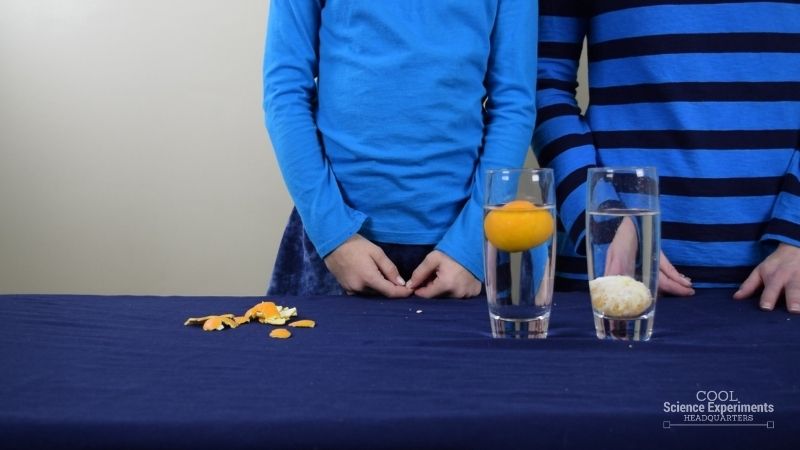Can you predict why the heavier orange floats? Experimenting with objects to determine what will float and what will sink is always educational and fun!
In this easy science experiment, kids explore and test density while learning more about buoyancy. It’s a quick experiment that will only take a few minutes to perform and offers the added bonus of snacking on the oranges while you discuss the outcome!
A materials list, printable instructions, and a demonstration video are included along with a simple explanation of how the experiment works.

JUMP TO SECTION: Instructions | Video Tutorial | How it Works | Purchase Lab Kit
Supplies Needed
- 2 Oranges (We used Clementine’s, but any orange will work)
- 2 Glasses or Containers (Note: They must be big enough to put an orange into.)
- Water
Orange Float Lab Kit – Only $5
Use our easy Orange Float Science Lab Kit to grab your students’ attention without the stress of planning!
It’s everything you need to make science easy for teachers and fun for students — using inexpensive materials you probably already have in your storage closet!
Why Does the Heavier Orange Float Science Experiment Instructions

Step 1 – Begin with 2 empty glasses or containers. (Note: They must be big enough to put an orange into.)

Step 2 – Fill each container 3/4 of the way full with water.

Step 3 – Slowly and carefully place an orange in one of the containers. What happens to the orange? Does it float or does it sink?

Step 4 – Next, remove the peel from the second orange.

Step 5 – Slowly and carefully place the peeled orange in the second container. What happens to this orange? Does it float or sink?

Do you know the why the heavier orange floated and the lighter orange sank? Find out the answer in the how does this experiment work section below.
Video Tutorial
Why Does the Heavier Orange Float? Science Experiment Step by Step Instructions
How Does the Science Experiment Work
An orange with a peel is heavier than an orange without a peel. So why does the orange with the peel (the heavier one) float and the orange with the peel (the lighter one) sink?
The secret to this experiment is density! Density is a measure of the mass per unit volume of a substance. Water has a density of 1 g/mL (g/cm3). Objects will float in water if their density is less than 1 g/mL. Objects will sink in water if their density is greater than 1 g/mL.
The orange with the peel floats because the peel is porous and filled with tiny air pockets. These pockets of air help increase the buoyancy of the orange. This increase in buoyancy helps the orange become less dense than the water, so the orange will float in the water. Think of the pockets of air in the orange peel are like tiny floatation devices for the orange. On the other hand, when you remove the peel from the orange, you are in fact making it lighter, but you are also removing those tiny air pocket floatation devices. Therefore, the orange without the peel is denser than water and it sinks.
Buoyancy is the tendency of an object to float in fluids because of the upward force fluid exert on objects.
Orange Float Lab Kit – Only $5
Use our easy Orange Float Science Lab Kit to grab your students’ attention without the stress of planning!
It’s everything you need to make science easy for teachers and fun for students — using inexpensive materials you probably already have in your storage closet!
More Science Fun
If you liked this experiment, check out these other experiment dealing with density:
- Rainbow in a Jar – Create a Rainbow by using liquids of different densities
- How Different Liquids Impact Magnets – Density also impacts magnetic force
- Mixing Oil & Water – Will the two liquids mix together? Only if you add a third ingredient into the mix
- The Floating Egg – Eggs naturally sink in water, but we made them float
- Bottle Diver – You can make a scuba diver move up and down in the water.
I hope you enjoyed the experiment. Here are some printable instructions:

Why Does the Heavier Orange Float Experiment
Materials
- Two Oranges (We used Clementines, but any orange will work)
- Two Glasses or Containers (Note: They must be big enough to put an orange into)
- Water
Instructions
- Begin with two empty glasses or containers. (Note: They must be big enough to put an orange into)
- Fill each container 3/4 of the way full with water.
- Slowly and carefully place an orange in one of the containers. What happens to the orange? Does it float or does it sink?
- Next, remove the peel from the second orange.
- Slowly and carefully place the peeled orange in the second container. What happens to this orange? Does it float or sink?



cool
The orange with the peel floats because the peel is porous and filled with tiny air pockets. These pockets of air make the orange to be less dense than water and cause it to float. On the other hand, when you remove the peel from the orange, you are in fact making it lighter, but you are also removing those tiny air pockets. Therefore, the orange without the peel is denser than water and it sinks.
But what if the orange has been grated, as in ‘Zesting’? One suspects that it will sink, as pores will have been sealed over.
Its so cool that the orange pelled will sink and the unpelled one will float.